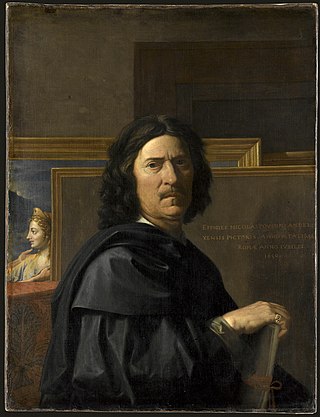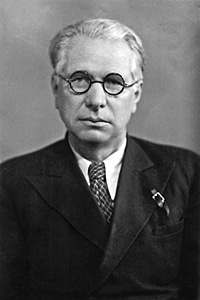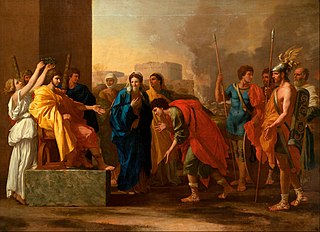
Nicolas Poussin was a French painter who was a leading painter of the classical French Baroque style, although he spent most of his working life in Rome. Most of his works were on religious and mythological subjects painted for a small group of Italian and French collectors. He returned to Paris for a brief period to serve as First Painter to the King under Louis XIII and Cardinal Richelieu, but soon returned to Rome and resumed his more traditional themes. In his later years he gave growing prominence to the landscape in his paintings. His work is characterized by clarity, logic, and order, and favors line over color. Until the 20th century he remained a major inspiration for such classically-oriented artists as Jacques-Louis David, Jean-Auguste-Dominique Ingres and Paul Cézanne.

Acis and Galatea are characters from Greek mythology later associated together in Ovid's Metamorphoses. The episode tells of the love between the mortal Acis and the Nereid (sea-nymph) Galatea; when the jealous Cyclops Polyphemus kills Acis, Galatea transforms her lover into an immortal river spirit. The episode was made the subject of poems, operas, paintings, and statues in the Renaissance and after.

Landscape with Polyphemus is a 1649 oil painting by French artist Nicolas Poussin. It is held in the Hermitage Museum, in Saint Petersburg.

Sergei Ivanovich Osipov was a Soviet painter, graphic artist, and art teacher, who lived and worked in Leningrad, a member of the Leningrad branch of Union of Artists of Russian Federation. He regarded as one of the representatives of the Leningrad school of painting, most known for his landscape and still life paintings.

Alexander Petrovich Koroviakov was a Soviet, Russian painter and art teacher, lived and worked in Leningrad – Saint Petersburg, a member of the Saint Petersburg Union of Artists, regarded as a representative of the Leningrad school of painting.

Rudolf Rudolfovich Frentz was a Soviet and Russian painter, watercolorist, graphic artist, illustrator and art teacher who lived and worked in Leningrad. He was a member of the Leningrad Union of Artists and one of the founders of the Leningrad school of painting, most famous for his battle and monumental painting.
Vladislav Leopoldovich Anisovich was a Russian and Soviet painter and art educator, who lived and worked in Leningrad, a member of the Leningrad Union of Soviet Artists, professor of the Repin Institute of Arts, regarded as one of representatives of the Leningrad School of Painting. Mostly known for his portrait paintings.
German Pavlovich Yegoshin was a Russian and Soviet painter and art educator, an Honored Artist of the Russian Federation, who lived and worked in Saint Petersburg. He was a member of the Leningrad Union of Soviet Artists, and was regarded as one of the representatives of the Leningrad School of Painting.

Retrospective Exhibition "In memory of Teacher. Exhibition of Saint Petersburg artists - students workshop of Alexander Osmerkin" became one of the notable event in the Saint Petersburg exhibition live of 1997 year. The Exhibition took place in Saint Petersburg in the Memorial Museum of Nikolai A. Nekrasov. There were exhibited 44 art works from private collections created by 12 pupils of Alexander Osmerkin. All them graduated Repin Institute of Arts in 1930-1950s.
The House of Creativity "Staraya Ladoga" was an all-Russian centre for artistic creativity, which existed in the Volkhovsky District of Leningrad Oblast from the mid-20th century up to the 1990s. It was located opposite the ancient village of Staraya Ladoga on the right bank of the Volkhov River.

Boris Fedorovich Borzin was born in Ukraine on 29 December 1923 and died in Saint Petersburg, Russia in 1991. He was a Soviet realism painter, graphic artist, conservator, art historian, author, and a tenured professor of fine art for 30 years at the Herzen State Pedagogical University of Russia. Borzin was also a veteran of the Great Patriotic War.

The Laundress or A Young Girl Doing Laundry is the title of three oil paintings by the French artist Jean Siméon Chardin. The subject of laundresses, also known as washerwomen, was a popular one in art, especially in France.

The State Museum of Modern Western Art was a museum in Moscow. It originated in the merger of the 1st and 2nd Museums of Modern Western Painting in 1923. It was based on the collection of paintings assembled by Sergei Schukin and Ivan Morozov. It was shut down on 6 March 1948 by Stalin and its works split between the Hermitage Museum in St. Petersburg and the Pushkin Museum in Moscow.

Aurora and Cephalus is an 1811 painting by Pierre-Narcisse Guérin, now in the Pushkin Museum in Moscow. Measuring 251 × 178 cm, it illustrates lines 661-866 of Book 7 of Ovid's Metamorphoses and is a version the artist's 1810 work of the same subject. An oil sketch for the 1811 work has been in the Hermitage Museum since 1978.

Frost in Louveciennes is an 1873 painting by Alfred Sisley, which has been in the Pushkin Museum since 1948. It shows the church of St Martin in the French town of Louveciennes. A chalk sketch for it is now in the Budapest Museum of Fine Arts.

Portrait of a Woman is a 1641 oil on panel painting by the Dutch artist Hendrick Cornelisz. van Vliet, now in Room 249 of the Hermitage Museum, in Saint Petersburg.

Holy Family, also called The Rest on the Flight into Egypt, is an oil on canvas painting by the French Rococo artist Antoine Watteau, now in the Hermitage Museum, Saint Petersburg. Variously dated between 1714 and 1721, Holy Family is possibly the rarest surviving religious subject in Watteau's art, related to either the Gospel of Matthew, or the Gospel of Pseudo-Matthew; it depicts the Virgin, the Christ Child, and Saint Joseph amid a landscape, surrounded by putti.

The Battle of the Milvian Bridge, The Battle of the Bridge or The Battle Between the Emperors Maxentius and Constantine is a 1655 oil on canvas painting by Claude Lorrain, now in the Pushkin Museum in Moscow. Despite the title, according to E. B. Sharnova, the painting has no historical specificity.

The Continence of Scipio is a 1640 oil on canvas painting by Nicolas Poussin, commissioned by Abbé Gian Maria Roscioli, secretary to Pope Urban VIII. It changed owners several times, reaching the Walpole collection in the first half of the 18th century, from which it was bought for the Hermitage Museum by Catherine the Great in 1779. It was reassigned to the Pushkin Museum in 1930, where it remains. The painting is based on the historical continence of Scipio.

The Rape of Europa is an oil on canvas painting by Claude Lorrain, from 1655. With its pendant The Battle of the Milvian Bridge, it is now in the Pushkin Museum, in Moscow.

















